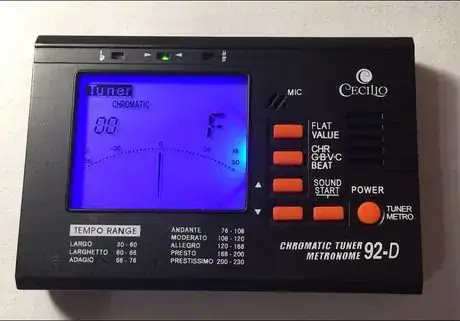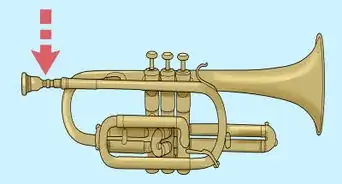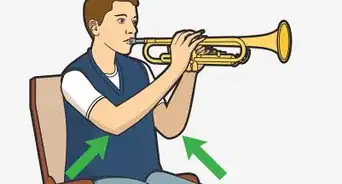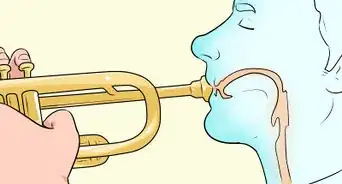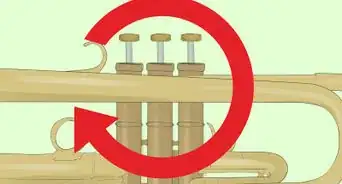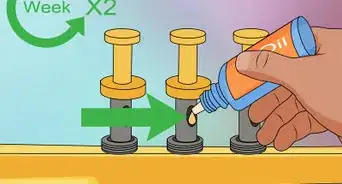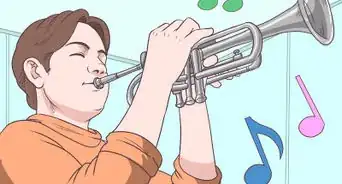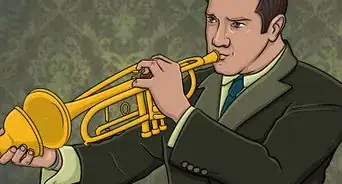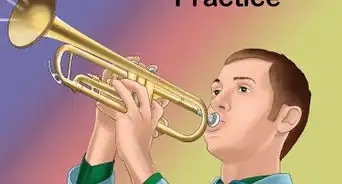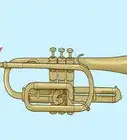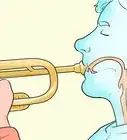wikiHow is a “wiki,” similar to Wikipedia, which means that many of our articles are co-written by multiple authors. To create this article, volunteer authors worked to edit and improve it over time.
This article has been viewed 30,903 times.
Learn more...
Being able to play a chromatic scale is an essential skill for any musician on any instrument. It is a great way to learn fingerings and to train your ear to remember what each note sounds like. This wikiHow guide will help you to learn to how to play a G chromatic scale (F Concert chromatic scale) on a Bb trumpet starting with a low G (Concert F) below the staff. This is a great way to warm up when you take out your trumpet as it allows you to play every note and gets your fingers and lips moving!
Steps
Playing the Lower G Chromatic Scale
-
1Play the first note.
- Tune your trumpet before beginning the scale. Tune to a C (this will register as a Bb Concert pitch on tuner) in the staff, which is an open fingering (0). It is important to be in tune before playing the scale because every note will sound incorrect if you do not. If your tuner displays a positive value, your trumpet is sharp. Fix this by pulling the tuning slide (the slide to the right of the bell) out, and play the C again in order to test your new pitch. If the tuner displays a negative value, your tuning is flat, meaning you will have to push the tuning slide in. Adjust the tuning slide as needed until a value between -5 and +5 is displayed for your C.
- Start the scale by playing the G below the staff (this will register as a F Concert pitch on tuner, as shown below). This is fingered by pressing the first and third valve (1 3). The first valve is the valve closest to the mouthpiece, and the third valve is the valve closest to the bell.
- Buzz your lips somewhat slowly to play lower notes.
- Use a tuner to establish the correct pitch will help to make sure you are playing the correct note. It will register as a concert F on your tuner.
-
2Move up the scale.
- Play the next note, Ab, by pressing the second and third valve (2 3), and buzzing your lips slightly faster and slightly tightening your embouchure. Again, use your tuner to ensure you are playing the correct pitch. It will register as an F#.
- Continue on to A, fingered (1 2). Make sure to continue to buzz your lips faster as you move up the scale. The tuner will register this note as a G.
- Play a Bb, fingered (1). This will register as a G#.
- Play a B, fingered (2). This will register as an A.
- Play a C. This will be an open fingering (0), and will register as a Bb. This is a common tuning pitch for the trumpet, as well as most other brass instruments.
- Continue onto a C#, fingered (1 2 3). It will register as a B. This note is inherently sharp on most trumpets. To remedy this, push out your third valve slide. Using the finger resting in the ring located near the bottom of the trumpet, slightly to the left of the tuning slide, push outward to extend the slide, flattening the tone. Check a tuner to find the correct pitch.
- Play a D, fingered (1 3). This will register as a C. This note also requires the third valve to utilized as it is typically sharp on most trumpets. Again, consult with the tuner to find the correct pitch.
- Play an Eb, fingered (2 3). This will register as a C#. At this point you will be entering the staff lines.
- Play a E, fingered (1 2). This will register as a D.
- Play a F, fingered (1). This will register as an Eb.
- Play an F#, fingered (2). This will register as a E.
- Play a G, which is an open fingering (0). This will register as a F.
Advertisement -
3Reach the top of the scale.
- Play the top note for an elongated period of time. Check your tuning and hold the note in order to improve your tone.
- Decide whether you want to play up to the next octave (method 2), which will take you to the G just above the staff, or if you want to return down the scale, which will take you back to where you started (method 4).
Playing the Upper G Chromatic Scale
-
1Play the first note.
- Start by playing the G in the staff. This will be found on the second line of the staff and will be an open fingering (0).
- Use a tuner and check your pitch before continuing up the scale. This note will register as a Concert F.
-
2Move up the scale.
- Play the next note, Ab, by pressing the second and third valve (2 3). It will register as an F#.
- Play an A, fingered (1 2). The tuner will register this note as a G.
- Play a Bb, fingered (1). This will register as a G#.
- Play a B, fingered (2). This will register as an A.
- Play a C. This will be an open fingering (0), and will register as a Bb.
- Play a C#, fingered (1 2). It will register as a B.
- Play a D, fingered (1). This will register as a C.
- Play an Eb, fingered (2). This will register as a C#.
- Play a E, which is an open fingering (0). This will register as a D.
- Play a F, fingered (1). This will register as an Eb.
- Play an F#, fingered (2). This will register as a E.
- Play a G, which is an open fingering (0). This will register as a F. At this point, you will be one space above the staff.
-
3Reach the top of the scale.
- Hold the top note (G) and check your tuning. This will help you to build up your lip muscles and improve your tone in the long run.
Moving Down the Upper Scale
-
1Play the top note of the scale.
- Play a high G (0) above the staff to begin descending the scale.
-
2Move down the scale from the upper octave.
- Buzz your lips slower and loosen your embouchure slightly with each note as you move down the scale.
- Play the notes in the following order: G (above the staff) (0), F# (2), F (1), E (0), Eb (2), D (1), C# (1 2), C (0), B (2), Bb (1), A (1 2), Ab (2 3), G (0).
-
3Finish the scale.
- Hold your last note, G (0), to reset your ear and prepare to move down the lower scale.
Moving Down the Lower Scale
-
1Play the top note of the scale.
- Play a G (0) in the staff, an octave lower than the starting pitch from the previous method, to begin descending the scale.
-
2Move down the scale from the lower octave.
- Continue to buzz your lips slower and loosen your embouchure as you move down the scale.
- Play the notes in the following order: G (second bar of the staff) (0), F# (2), F (1), E (1 2), Eb (2 3), D (1 3, third valve slide), C# (1 2 3, third valve slide), C (0), B (2), Bb (1), A (1 2), Ab (2 3), G (1 3).
-
3Finish the scale.
- Hold the last note, G, for a few second longer than the previous notes in order to finish your scale.
Things You'll Need
- Bb trumpet
- Tuner

